- Oil ended a three-day advance
- Yields at the lowest since March 23
- US futures fell with global stocks as US-China tensions reawaken
Key Events
The first full trading week of May opened in the red on Monday. US futures contracts for the Dow Jones, S&P 500, NASDAQ and Russell 2000 each dropped around 1% or more, European shares are significantly lower and Asian markets all closed down this morning.
The reason? A renewal of tensions between the US and China over the possible origins of the cornonvirus, which could rekindle trade tensions between the world's biggest economies.
Yields fell and gold jumped.
Global Financial Affairs
Yesterday, echoing President Donald Trump's bellicose accusations, US Secretary of State Mike Pompeo charged that COVID-19 originated in a Wuhan, China lab. He also said that the Asian nation's government wasn’t cooperating on information-sharing to help create a vaccine. This was a clear extension of Trump’s trade war revival threat from last week; there was even talk about America deleting its Chinese debt.
The world’s largest economies appear to be headed toward a cold war, which begs the question: can the US actually afford a cold war with China, the place where so many components of American corporate manufacturing are sourced?
Additional concerns are equally germane. Is the US consumer prepared to refrain from buying cheap goods imported from China? Can China withstand the potential loss of demand?
Which leads to one wondering, who has more power in this supply-demand equation? Last year, big American companies were already in search of new, inexpensive regional locations from where they could manufacture their goods, as the US-Sino trade war escalated in 2018-2019.
If current tensions continue to escalate, there might be another seismic shift in global commerce on the horizon that would restructure the business landscape.
As of early Monday, all four major US contracts are down, having been ranging for the past six hours, after rebounding from a lower open.
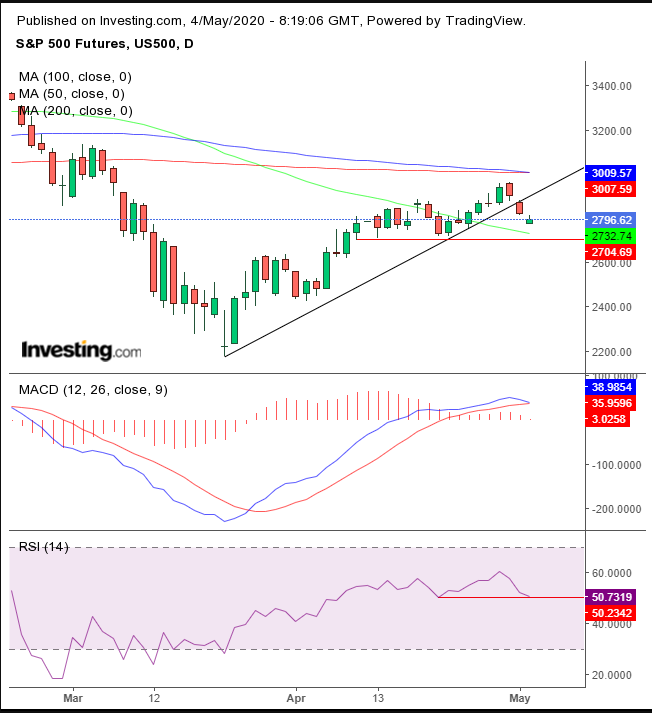
S&P 500 futures fell for the third day, extending Friday’s penetration of its uptrend line since the March 23 bottom. A fall below 2,700 would be the second trend reversal confirmation, which would include sell signals from the RSI and MACD.
The Stoxx Europe 600 Index dipped this morning, pressured by all 19 industry sectors. It's the pan-European’s third consecutive decline, pushing it below its uptrend line—guarded by the 50 DMA—since the March bottom.
Asian indices took the biggest hit, however. Hong Kong’s Hang Seng plunged the most in six weeks, (-4.5%), as investor sentiment suffered ahead of the special administrative region's Q1 GDP, seen to have been decimated by the coronavirus. Chinese and Japanese markets were closed for holidays.
Yields, including for the benchmark 10-year Treasury, fell to the lowest since April 23, on a daily basis.
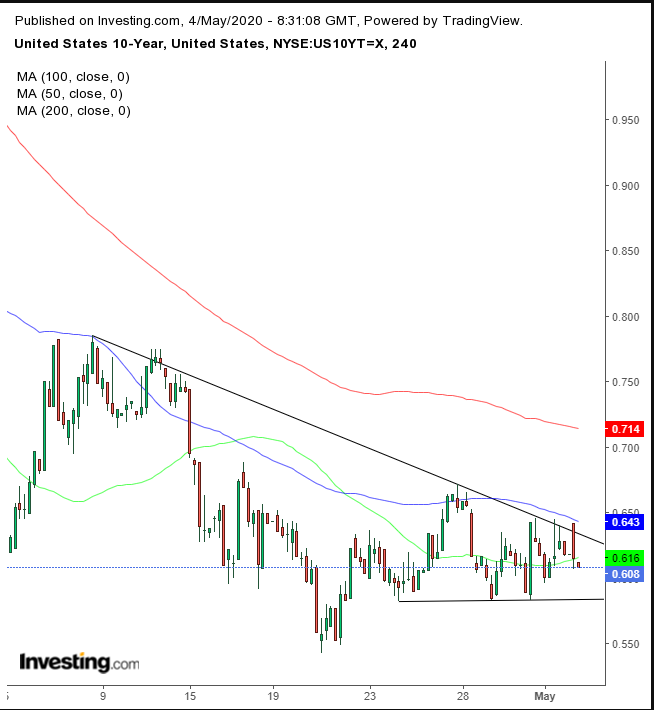
On the four-hour chart, rates may be developing a H&S continuation pattern that would extend the downtrend.
The dollar gapped higher.
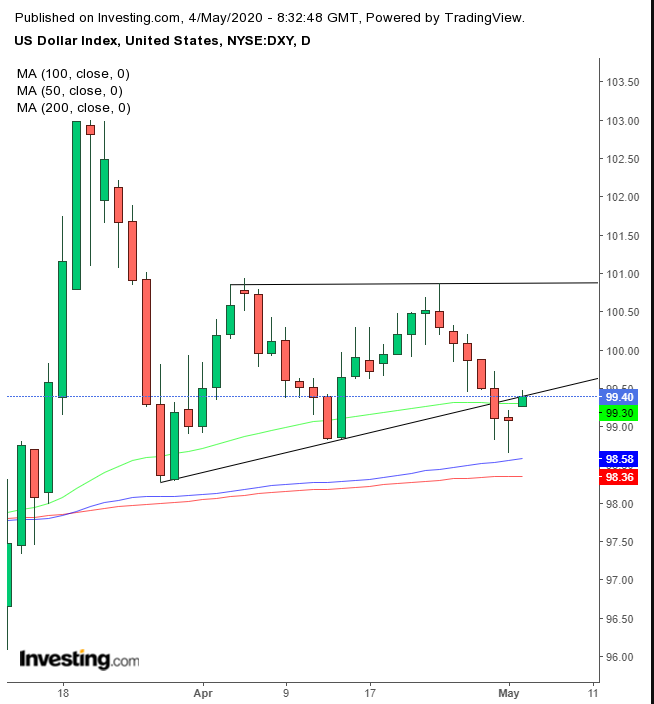
However, it found resistance at the bottom of a counterintuitive ascending triangle that developed after a fall rather than a rise.

Gold jumped, despite being weighed down by a stronger dollar, confirming our hunch that the precious metal is developing a pennant, whose continuation characteristics would support the H&S continuation pattern that preceded it. Note, the pennant is complete upon an upside breakout, which also generally pulls the price back to retest the pattern’s integrity.
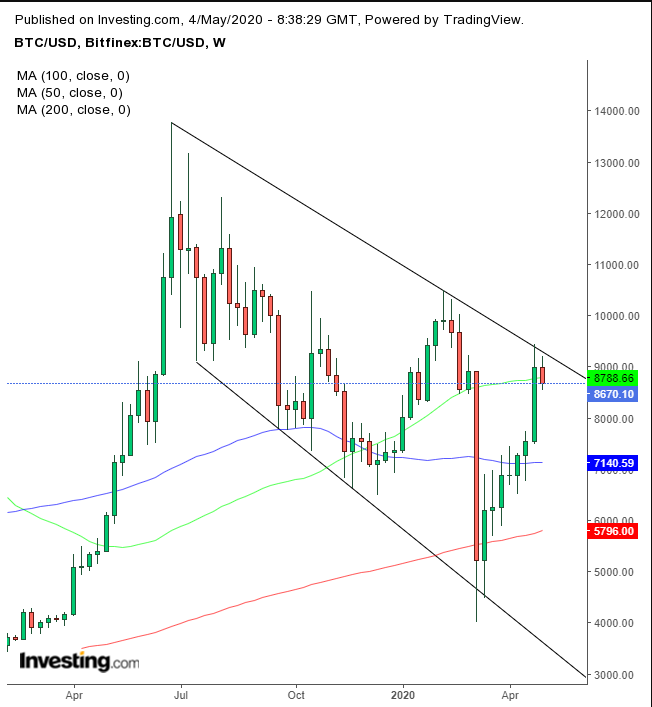
Bitcoin fell for the second day after slightly penetrating the top of a falling channel since the June 25, $11,780 high and retreating, confirming its resistance. The supply-demand dynamics of the falling channel suggest a return to $4,000, the March lows.
WTI crude fell today, ending a three-day advance.
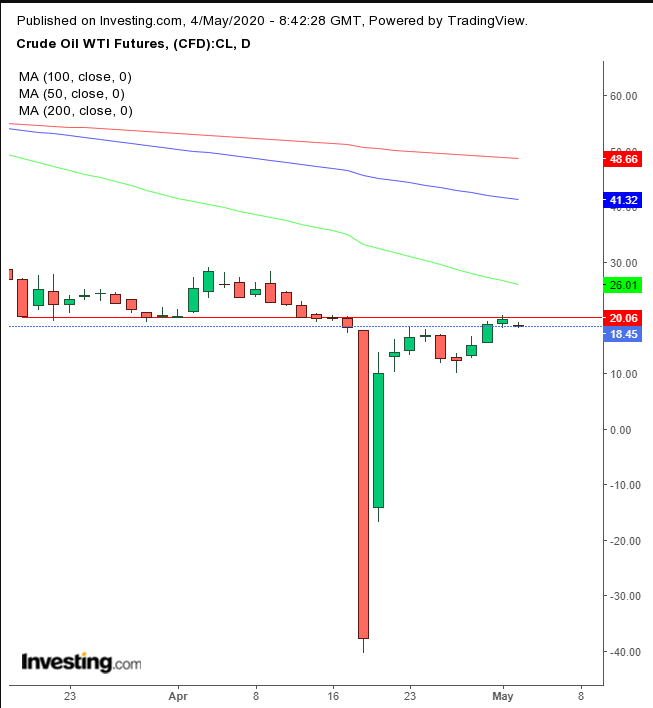
There is an argument to be made that “a major bull run is forming in oil markets,” but until that happens, we remain bearish. The $20 level is our red line. The price tested that resistance on Friday but closed below. Today, the price continued to decline.
Up Ahead
- Regional Federal Reserve chiefs are due to speak, including Charles Evans and James Bullard.
- The Reserve Bank of Australia has a policy decision on Tuesday and the Bank of England on Thursday.
- Friday brings the US Nonfarm Payrolls report for April, expected to show severe impact from the pandemic. The median forecast calls for a 21 million plunge in jobs created.
Market Moves
Stocks
- The Stoxx Europe 600 Index tumbled 2.5%.
- Futures on the S&P 500 Index fell 0.8%.
- France’s CAC 40 Index slumped 3.7%.
- Hong Kong’s Hang Seng Index sank 4%.
Currencies
- The Dollar Index jumped 0.4%.
- The euro dipped 0.4% to $1.0935.
- The British pound declined 0.5% to $1.2445.
- The Japanese yen strengthened 0.1% to 106.78 per dollar.
- The South Korean won weakened 0.7% to 1,229.04 per dollar.
Bonds
- The yield on 10-year Treasuries fell one basis point to 0.60%.
- Germany’s 10-year yield climbed two basis points to -0.56%.
- Britain’s 10-year yield decreased one basis point to 0.237%.
- The spread of Spain's 10-year vs Germany's 10-year increased two basis points to 1.331 percentage points.
Commodities
- West Texas Intermediate crude fell 6.9% to $18.42 a barrel.
- Brent crude fell 1.7% to $25.99 a barrel.
- Gold strengthened 0.3% to $1,705.57 an ounce.
